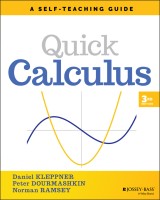Details

Quick Calculus
A Self-Teaching GuideWiley Self-Teaching Guides 3. Aufl.
|
16,99 € |
|
| Verlag: | Wiley |
| Format: | EPUB |
| Veröffentl.: | 19.04.2022 |
| ISBN/EAN: | 9781119743491 |
| Sprache: | englisch |
| Anzahl Seiten: | 304 |
DRM-geschütztes eBook, Sie benötigen z.B. Adobe Digital Editions und eine Adobe ID zum Lesen.
Beschreibungen
<b>Discover an accessible and easy-to-use guide to calculus fundamentals</b> <p>In <i>Quick Calculus: A Self-Teaching Guide, 3rd Edition</i>, a team of expert MIT educators delivers a hands-on and practical handbook to essential calculus concepts and terms. The author explores calculus techniques and applications, showing readers how to immediately implement the concepts discussed within to help solve real-world problems. <p>In the book, readers will find: <ul> <li>An accessible introduction to the basics of differential and integral calculus</li> <li>An interactive self-teaching guide that offers frequent questions and practice problems with solutions.</li> <li>A format that enables them to monitor their progress and gauge their knowledge</li> </ul> <p>This latest edition provides new sections, rewritten introductions, and worked examples that demonstrate how to apply calculus concepts to problems in physics, health sciences, engineering, statistics, and other core sciences. <p><i>Quick Calculus: A Self-Teaching Guide, 3rd Edition</i> is an invaluable resource for students and lifelong learners hoping to strengthen their foundations in calculus.
<p>Preface iii</p> <p><b>Chapter One Starting Out 1</b></p> <p>1.1 A Few Preliminaries 1</p> <p>1.2 Functions 2</p> <p>1.3 Graphs 5</p> <p>1.4 Linear and Quadratic Functions 11</p> <p>1.5 Angles and Their Measurements 19</p> <p>1.6 Trigonometry 28</p> <p>1.7 Exponentials and Logarithms 42</p> <p>Summary of Chapter 1 51</p> <p><b>Chapter Two Differential Calculus 57</b></p> <p>2.1 The Limit of a Function 57</p> <p>2.2 Velocity 71</p> <p>2.3 Derivatives 83</p> <p>2.4 Graphs of Functions and Their Derivatives 87</p> <p>2.5 Differentiation 97</p> <p>2.6 Some Rules for Differentiation 103</p> <p>2.7 Differentiating Trigonometric Functions 114</p> <p>2.8 Differentiating Logarithms and Exponentials 121</p> <p>2.9 Higher-Order Derivatives 130</p> <p>2.10 Maxima and Minima 134</p> <p>2.11 Differentials 143</p> <p>2.12 A Short Review and Some Problems 147</p> <p>Conclusion to Chapter 2 164</p> <p>Summary of Chapter 2 165</p> <p><b>Chapter Three Integral Calculus 169</b></p> <p>3.1 Antiderivative, Integration, and the Indefinite Integral 170</p> <p>3.2 Some Techniques of Integration 174</p> <p>3.3 Area Under a Curve and the Definite Integral 182</p> <p>3.4 Some Applications of Integration 201</p> <p>3.5 Multiple Integrals 211</p> <p>Conclusion to Chapter 3 219</p> <p>Summary of Chapter 3 219</p> <p><b>Chapter Four Advanced Topics: Taylor Series, Numerical Integration, and Differential Equations 223</b></p> <p>4.1 Taylor Series 223</p> <p>4.2 Numerical Integration 232</p> <p>4.3 Differential Equations 235</p> <p>4.4 Additional Problems for Chapter 4 244</p> <p>Summary of Chapter 4 248</p> <p>Conclusion (frame 449) 250</p> <p><b>Appendix A Derivations 251</b></p> <p>A.1 Trigonometric Functions of Sums of Angles 251</p> <p>A.2 Some Theorems on Limits 252</p> <p>A.3 Exponential Function 254</p> <p>A.4 Proof That dy/dx = 1/dx∕dy 255</p> <p>A.5 Differentiating X<sup>n</sup> 256</p> <p>A.6 Differentiating Trigonometric Functions 258</p> <p>A.7 Differentiating the Product of Two Functions 258</p> <p>A.8 Chain Rule for Differentiating 259</p> <p>A.9 Differentiating Ln X 259</p> <p>A.10 Differentials When Both Variables Depend on a Third Variable 260</p> <p>A.11 Proof That if Two Functions Have the Same Derivative They Differ Only by a Constant 261</p> <p>A.12 Limits Involving Trigonometric Functions 261</p> <p><b>Appendix B Additional Topics in Differential Calculus 263</b></p> <p>B.1 Implicit Differentiation 263</p> <p>B.2 Differentiating the Inverse Trigonometric Functions 264</p> <p>B.3 Partial Derivatives 267</p> <p>B.4 Radial Acceleration in Circular Motion 269</p> <p>B.5 Resources for Further Study 270</p> <p>Frame Problems Answers 273</p> <p>Answers to Selected Problems from the Text 273</p> <p><b>Review Problems 277</b></p> <p>Chapter 1 277</p> <p>Chapter 2 278</p> <p>Chapter 3 282</p> <p><b>Tables 287</b></p> <p>Table 1: Derivatives 287</p> <p>Table 2: Integrals 288</p> <p><b>Indexes 291</b></p> <p>Index 291</p> <p>Index of Symbols 295</p>
<P><B>Daniel KLEPPNER</B> is the Lester Wolfe Professor of Physics at MIT. He was awarded the National Medal of Science and the Oersted Medal of the American Association of Physics Teachers. <P><B>peter DOURMASHKIN</B> is Senior Lecturer at MIT. <P>The late <B>Norman RAMSEY</B> was the Higgins Professor of Physics at Harvard University and the recipient of the 1989 Nobel Prize in Physics.
<P><B>An accessible and straightforward handbook to the basics of calculus</B></P> <P>In the newly revised third edition of<I> Quick Calculus, </I>a team of expert educators delivers a practical, comprehensive, and easy-to-use guide to understanding essential calculus concepts and terms. The book emphasizes technique and application—in contrast to rigorous mathematical proofs—which makes the book an excellent choice for readers who hope to immediately apply calculus concepts to real problems. <P><I>Quick Calculus</I> offers an interactive self-teaching format that provides frequent questions and practice problems, increasing the speed and depth of learning and retention. Included self-tests allow readers to monitor their progress and gauge their knowledge. The authors describe the basic principles of differential and integral calculus in a friendly and accessible style, presenting a singular jumping-off point to more rigorous mathematical approaches. <P>The latest edition offers rewritten introductions and new sections with worked examples that demonstrate the application of calculus to classic problems. These empower the reader to enter the world of differential equations and to apply calculus to a wide spectrum of disciplines. <P><I>Quick Calculus, Third Edition</I> is an essential companion for any student or lifelong learner seeking a foundational understanding of calculus.

















